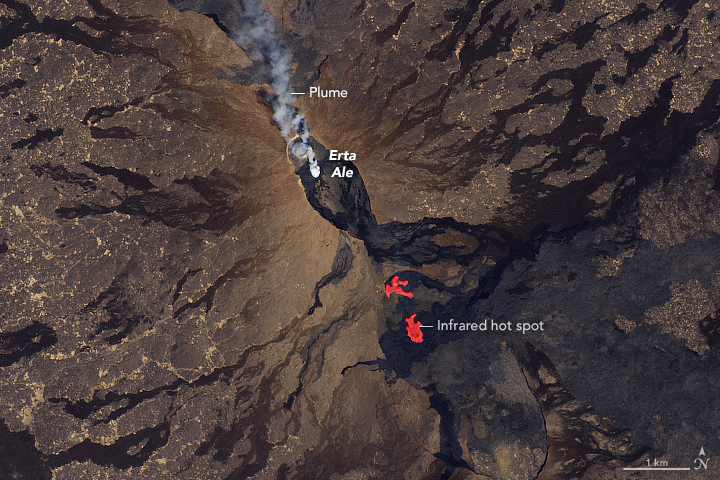
Fissure Eruptions on Erta Ale
Downloads
- ertaale_oli_2017026_lrg.jpg (1808x2292, JPEG)
Metadata
- Sensor(s):
- Landsat 8 - OLI
- Data Date: January 26, 2017
- Visualization Date: January 27, 2017
Erta Ale has a long-lived lava lake that has gurgled and spattered in its caldera for decades, but the most recent bout of activity involves the southeast flank of the gently sloping mountain. According to reports posted by Volcano Discovery, new fissures opened up on January 21, 2017, about 7 kilometers (4 miles) from the summit caldera, spilling large amounts of lava. Meanwhile, at least one of the lava lakes has experienced large changes in the level of its lava that have led to overflows and intense spattering.
This image was captured by the Operational Land Imager (OLI) sensor on Landsat 8 on January 26, 2017. It is a composite of natural color (OLI bands 4-3-2) and shortwave infrared (OLI band 7). Shortwave infrared light (SWIR) is invisible to the naked eye, but strong SWIR signals indicate increased temperatures. Infrared hot spots representing two distinct lava flows are visible. Plumes of volcanic gases and steam drift from the lava lakes.
References
- Atlas Obscura (2017, January 25) Erta Ale. Accessed January 27, 2017.
- Global Volcanism Program Erta Ale. Accessed January 27, 2017.
- The Watchers (2017, January 25) New flank eruption at Erta Ale volcano, Ethiopia. Accessed January 27, 2017.
- Volcano Discovery (2017, January 25) Erta Ale volcano (Ethiopia): new flank eruption reported. Accessed January 27, 2017.
NASA Earth Observatory image by Joshua Stevens, using Landsat data from the U.S. Geological Survey. Caption by Adam Voiland.
This image record originally appeared on the Earth Observatory. Click here to view the full, original record.